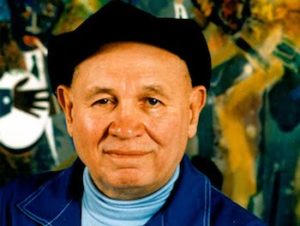
Romare Bearden
On this date in 1911, Romare Bearden, a Black artist, was born.
Born Fred Howard Romare Bearden in Charlotte, N.C., he was the only child of Richard Howard and Bessye Bearden. He grew up primarily in the Harlem district of New York City. His mother’s work as New York editor for the Chicago Defender newspaper and as a social activist brought Bearden into contact with the writers, artists, and musicians of the Harlem Renaissance, a high point of Black intellectual and cultural life during the 1920s. Bearden’s lifelong interest in Black art and in jazz and blues music dates from this period.
He studied at New York University, receiving his B.A. degree in 1935. While a student, he drew cartoons for the university’s humor magazine, Medley, and submitted political cartoons and drawings to such publications as the Baltimore Afro-American, Collier’s Magazine, and the Saturday Evening Post. In the late 1930s, Bearden attended the Art Students League, where he worked with German-American expressionist artist George Grosz. During the late 1950s and early 1960s, Bearden began experimenting with abstraction. His technique involved applying broad areas of color in various thicknesses on rice paper and then gluing the painted papers on canvas, usually in several layers. He then tore sections of the paper away and added more paper until a motif or image presented itself. He completed the work by painting additional elements.
Bearden produced some of his most innovative works in the late 1960s. Often incorporating life-sized imagery, these works combine collages with acrylics, oils, mosaics, and black-and-white photographs. Bearden experimented with various forms and styles over the years, and his work reflects his interest in the 20th-century art movements of cubism, social realism, and abstraction.
During the 1970s and 1980s, his subject matter emphasized African American myth and everyday experience. Bearden’s paintings and collages show many aspects of the Black experience. The small college “Family” (1988) served as the model for a much larger piece made of ceramic tiles displayed at the Joseph P. Addabbo Federal building in the New York City borough of Queens.
Bearden’s long-term association with the island of Saint Martin in the West Indies, where his wife had family, is evident in works throughout his career. “Pepper Jelly Lady” (1980), a colorful lithograph, depicts a woman selling her pepper jelly in front of a walled estate. A wide border of single-color line drawings sets off the vibrant central image.
Bearden coauthored several books on African American artists, including “Six Black Masters of American Art” (1972) and “A History of African American Artists” (1992). In 1987, a year before his death, American President Ronald Reagan awarded Bearden the National Medal of Arts.
One of the 20th century’s most important, Romare Bearden, died on March 12, 1988.
Reference Library of Black America Volumes 1 through 5
Edited by Mpho Mabunda
Copyright 1998, Gale Research, Detroit, MI